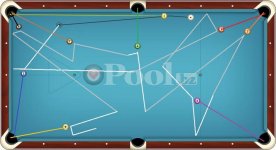A little more......
As way of a tip, about how one should think when planning an out, either on a real table or a virtual one.
Here's the table, and some thoughts below:
2 ball only goes easily to bottom left. I can draw off the 1, but speed control is easier with follow.
I give myself an angle, so I'm not left on the rail with my shot to the 2 ball. I can go off a rail with some inside or put the CB nearer the rail and CB doesn't touch a rail. I prefer a touch of inside, giving me a more open bridge and slighly better angle than the pure roll through without touching the side rail... but no big deal here if you're comfortable with inside english. If not, go the roll through with no rail hit with the CB.
Must pass the 7, but don't want to go to far, as you'll want an angle on the 2 ball. An option is to play down to the head rail, but the 8 ball could get in the road, and generally, it's better percentage to play from above the ball, rather than below, as it offers more angle options with the next positional shot.
From 2 to 3, I'm better off running too far than not far enough. The best angle here is to play from the 3 into the side rail rather than try to get perfect for a draw shot to the 4 using no rails. Even a fine cut on the 3 is better than being dead straight on it. In fact, I'd almost prefer to bank it, than be dead straight on it, in terms of getting position to the 4 well.
From 4 to 5, to get to the 6, almost anything works. An angle either side may be easier for a beginner.
The main objective is getting pretty straight on the 6, not that it's crucial, bit if you do so, then the out is simple, so long as you don't finish dead straight on the 8 ball, in which case, you may have to take a long 9 to the right end corner, which would still be a 90% shot for a good shooter so long as you don't get the CB right up against the 9-ball or on a terrible angle to shoot it.
So that's a sample of the mental process of planning an out. I think it's a good idea to train one's mind at this both on and away from the table, and then compare your predictions with your own capabilities when actually at the table.
As you know, you don't learn to solve the rubik's cube with thousands of hours of random shuffling, you learn it when still, thinking upon the subject.
Colin
